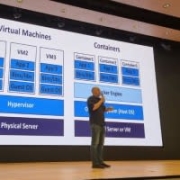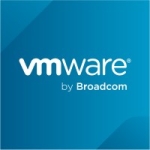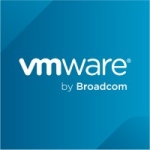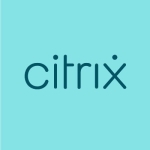
Red Hat OpenShift Valuable Features
We have certain applications on-prem on physical servers. We had some on Windows and some on Linux. There we had requirements where every time we had to manage extra load, we had to spawn a new Tomcat node. Scaling was one of the issues we were facing, and every time we had to scale up, it was a challenge. Plus, we had to procure infrastructure and do a lot of configuration and setup for the new instance being launched.
Once we set that up, scaling down was a challenge as we did not always bring that down when not needed. When we did not have too much traffic, we still had a lot of infrastructure lying idle. At the same time, when we had high load, we were not able to scale up quickly.
There was too much patching that happened, and every time we had to patch something it became a challenge. There were versioning issues with operating systems versus Java and other technologies we were using. That is why we moved to containerization, where we defined what operating system we need, what Java version we need, and what steps we want to do. Containerization helped us create that one unit we wanted to deploy. Red Hat OpenShift helped us with managing scaling up and scaling down.
Because it was centrally managed in our company, many metrics that we had to write code for were available out of the box, including utilization, CPU utilization, memory, and similar metrics. We performed multiple transformations from physical servers to Red Hat OpenShift, and some from virtual servers to Red Hat OpenShift.
The OC utility tool is something we use very often for replication, replica sets, and config maps for managing all environments and secrets. This is very useful for us. Routing is another beneficial feature we get, so we do not need to manage or do too many things for load balancing.
View full review »Most benefit from it, however, I work with Kubernetes, and installing Vanilla Kubernetes is easy. That said, it introduces many tools that need to be set up individually. OpenShift comes ready out of the box, with all tools installed and configured. Red Hat certifies and confirms that all the components are compatible with each other.
OpenShift's superior dashboard is a notable strength, especially when compared to Kubernetes. The integrated DevOps capabilities, such as pipelines and the container registry, are extremely beneficial.
Additionally, its capability to monitor microservices and containers with integrated tools like Prometheus is a major advantage. The horizontal pod scaling exceeds the scalability features I found in Kubernetes.
View full review »JU
Jefferson Usianene
Infrastructure Manager at Appzone Group
OpenShift is a spin-off of Kubernetes, built on top of Kubernetes. It has features that enhance security, ease of deployment, and service exposure compared to Kubernetes. It also provides good integration with GitOps and ArgoCD.
Additionally, OpenShift offers an easy-to-use graphical user interface for cluster management, making it more accessible for administrators.
View full review »Buyer's Guide
Red Hat OpenShift
October 2025
Learn what your peers think about Red Hat OpenShift. Get advice and tips from experienced pros sharing their opinions. Updated: October 2025.
871,358 professionals have used our research since 2012.
UM
UsmanMalik
Manager IT Infrastructure at a government with 1,001-5,000 employees
The concept of containers and scaling on demand is a feature I appreciate the most about Red Hat OpenShift.
Our solutions can easily scale to any number of users or requests if we are running on the cloud. The cloud also supports the pay-as-you-go model, so scalability is the biggest benefit.
View full review »SA
Shan Ahmed
System Analyst at Freelancer
A valuable feature of Red Hat OpenShift is its ability to handle increased loads by automatically adding nodes. This automation impresses us and benefits us in managing loads on applications.
Although we have just started the transition and are moving slowly, OpenShift has been helpful in modernizing our applications, and it is a positive step forward.
View full review »AJ
AbdulJaleel
Senior Technical Lead at MORO
Scalability and High Availability: OpenShift makes it easy to scale applications horizontally or vertically based on demand. Its high-availability capabilities ensure reliability and minimize downtime.
Built-in Security Features: Enhanced security tools like role-based access control (RBAC), network segmentation, and image vulnerability scans protect containerized applications.
Operator Framework: This simplifies the management of Kubernetes applications, automating tasks like installation, upgrades, and maintenance.
View full review »JK
Jan Kappert
OpenShift consultant at HCS Company
OpenShift offers more stability than Kubernetes. With OpenShift, we get a complete ecosystem around the developer, which includes extras that aren't available with Kubernetes. If we build in a Kubernetes environment ourselves, we have to do a lot of work to get it on the same level as OpenShift. One of the nicest parts of OpenShift is the UI, which allows developers to log on and start building their applications very quickly. The integrations are essential to OpenShift, including pipelining and service mesh.
By default, OpenShift is very secure. Out of the box, our role access is in place. We can easily connect to our active directory or our open ID providers. The constraints in the platform are also secure by default. OpenShift is one of the most secure solutions out of the box.
OpenShift's security features for writing business-critical applications are okay. In addition to OpenShift, we use advanced security calls to help developers and application teams keep their applications and projects secure. This depends on a lot of factors, such as the type of application. We work to keep our deployments and applications secure on container versions and solutions, as well as within our applications. We help customers set up their baselines. We recommend not running the applications on the root and staying as close to Kubernetes or OpenShift as possible. This is all we need to do in order to be successful with baselines.
OpenShift has made a lot of strides in the last few months including moving the dashboards to an OpenShift UI making it much easier for a developer to track applications and they no longer need an extra portal to show the metrics or log off their applications.
There are many advantages of using multiple Red Hat products together starting with the integration. We have a one-stop shop for support and we can bundle the products for a huge discount.
View full review »MB
Matthias Bertschy
Senior Kubernetes Architect at a financial services firm with 1,001-5,000 employees
OpenShift is based on Kubernetes and we try to use all the Kubernetes objects of OpenShift. We don't use features that are specific to OpenShift, except internal certificates for the services. The one feature that is missing from Kubernetes and that is really useful in OpenShift is the lifecycle of the cluster and the ease of installation. We use VMware and VMware integration internally with the OpenShift installer, which is very good. With OpenShift it's easy to spin up or scale out a cluster.
OpenShift's security throughout the stack and the software supply chain is good.
The defaults in OpenShift are favorable and secure. Red Hat usually takes a lot of time to ensure compliance with the CIS benchmark and by default, it's the most secure out-of-the-box solution for security.
OpenShift's security features for running business-critical applications are suitable.
The solution is very reliable. We have excellent documentation, and we get good support for open-source products. If we need to learn new features or do new types of implementation, documentation is available.
In terms of implementation, OpenShift is very user-friendly, which is an advantage. We are using it along with GitLab for implementing CI/CD pipelines. That's a feature that other products also have, but in OpenShift, we find it good.
Upgrades are easy. We could do upgrades with a single click. The GUI is very user-friendly. We are also very comfortable with the CLI.
View full review »ES
EisaShaheen
DevOps Engineer at Nudtteo
One of the most valuable features of OpenShift for our operations is its auto-scaling capability. This feature is crucial for handling high loads or traffic spikes in our applications. With OpenShift, we have the flexibility to scale our applications up or down as needed, providing a significant benefit to our operations.
OpenShift offers robust tools for monitoring application traffic, allowing us to analyze client requests and other business-related metrics. This enables us to effectively manage our applications and make informed decisions to optimize performance.
Overall, the solution's security throughout the stack and software supply chain is excellent.
OpenShift offers great security thanks to role-based access control and segregation between projects. The security is very good, even for mission-critical projects.
The product provides us with the flexibility and efficiency of cloud-native stacks while enabling us to meet regulatory constraints. Furthermore, it doesn't require us to learn a whole new vocabulary, there is no vast stepping stone regarding configuration and management, and we aren't cloud-locked. If we want to move our OpenShift solution to another cloud provider, or even our private data center, that's doable. The tool is better in terms of application management than anything found in the cloud, and one of the main selling points of OpenShift is the abstraction of infrastructure.
What I like best about OpenShift is that it can reduce some of the costs of having multiple applications because you can just move them into small container applications. For example, applications don't need to run for twenty days, only to be used up by Monday. Through OpenShift, you can move some of the small applications into any cloud.
I also find the design of OpenShift good.
View full review »Valuable features include time to market, avoiding vendor lock-in, and the ease of working in a multi-cloud environment. This flexibility allows the use of multiple cloud platforms such as AWS, Microsoft, Google, and IBM.
View full review »JA
Javeed Abdul
Senior System Engineer at a tech consulting company with 10,001+ employees
The most valuable features of the solution stem from the product's GUI, and other such areas of the product have been set up. Compared to AWS, OpenShift is better.
View full review »AS
AbhinavSingh
Technical Marketing Engineer - Hybrid Cloud Infrastructures at a manufacturing company with 10,001+ employees
The most valuable feature of OpenShift is the security context constraint (SCC). The solution’s security throughout the stack is good. And security context constraints provide port-level security. It's a granular level of control, where you can give privileges to certain users to work on certain applications. That's a great security feature.
The solution also provides a lot of security features on top of a regular Kubernetes cluster, which you can control. For example, in the namespace of OpenShift, there are different kinds of access levels. If you have a development team, you can provide limited access so that a developer can only deploy your application. If you're running any business-critical app, you can restrict the users' access to that app.
Also, Red Hat provides advanced multi-cluster management. You can manage multiple clouds with one solution, and I'm happy with that.
View full review »Its security is most valuable. It's by default secure, which is very important.
It's very easy to manage deployment across different environments. It doesn't matter if it's a private or a hybrid cloud. It's very well-suited for the type of work that we do, which is the deployment for our PoCs. It's very easy to start with small ideas and then gradually scale up.
It's very easy to integrate with different systems and products, which is another plus point.
It also has a very nice user interface. It's very self-explanatory, and that saves a lot of time from training new users. You can cut a lot of time to quickly familiarize yourself with the base.
OperatorHub is another big plus. It's very easy to use and very useful.
The self-healing of pods is a valuable feature. This feature goes a long way in helping us ensure our uptime for services, improving the performance of the system.
The solution provides us with the flexibility of cloud-native stacks while enabling us to meet regulatory constraints. Since most of our services were deployed on-premises, this allowed us not to get into data privacy issues for services with personally identifiable information belonging to customers. It is microservice-ready from a cloud-native perspective, which is a benefit.
With the automation that OpenShift gives you, you can automate as much as possible. This goes a long way in reducing time to market and errors due to human intervention. So, if an organization can do a lot of automation, e.g., automating deployments, that can go a very long way in reducing the time to market and the time required to fix issues that arise out of deployment.
View full review »The solution offers ease with which we can define how to run applications and configure them. It's much more convenient than creating a virtual machine and configuring application servers, making the process faster and simpler.
View full review »The most valuable features are that
- it's cloud agnostic
- the containerization and security features are outstanding.
The cloud-agnostic aspect means I can move to AWS, Google, or Azure. That means it is not a limitation. It gives me flexibility.
For running business-critical applications, on a scale of one to five, where five is the best, OpenShift is 4.8.
I like OCP, and the management UI is better than the open-source ones.
The integration with 3scale is very good. We use that too.
View full review »Two stand-out features are the security model and value-add features that don't exist in Upstream Kubernetes. OpenShift's security throughout the stack and the software supply chain is pretty robust. Including advanced cluster security, OpenShift covers almost everything out of the box.
We are also using Linux Rail and Ansible, and all these Red Hat products have some awareness. However, it's hard to say because some of them previously existed as non-Red Hat products.
JS
John Schiwitz
PaaS Support Engineer at a outsourcing company with 10,001+ employees
The developers seem to like the source-to-image feature. That makes it easy for them to deploy an application from code into containers, so they don't have to think about things. They take it straight from their code into a containerized application. If you don't have OpenShift, you have to build the container and then deploy the container to, say, EKS or something like that. It's a little different.
In terms of the solution’s security throughout the stack and the software supply chain, it meets our needs. It's excellent as far as we're concerned. It goes right along with the Kubernetes role-based assets control. OpenShift's security features for running business-critical applications are excellent. A lot of our external-facing applications have been protected. We do use Apigee for a lot of it, but we also do security scans so we don't expose something to a known vulnerability.
I am impressed with the product's security features.
View full review »The deployment is easy.
The security is good. I'd rate it 4.5 or five out of five. I'm satisfied with the security on offer.
The product can scale well automatically.
OpenShift can be deployed on-premises and on the cloud. It helps us comply with regulatory issues that would require at least a portion to be covered by on-prem usage.
The automated processes are really great. It helps with development time and the end product quality. It helps by being so flexible, which translates into easier development. It helps take some stuff off our plate.
The solution's code ready workspaces have reduced project onboarding time. It's really simple to deploy on OpenShift. The reduction levels have been around 35%. It also reduces time to market due ot the faster development times. The reduction has been around almost 20% based on some administration we ned to handle in order to maintain compliance.
PR
Pawan Ramekar
Software engineer at ACI Worldwide
The most valuable feature is the auto scalers for all microservices. The feature allows us to place request limits and it is much cheaper than AWS.
View full review »Its interface is good. The other part is the seamless integration with the stack that I have. Because my stack is mostly of Red Hat, which is running on top of VMware virtualization, I have had no issues with integrating both of these and trying to install them. We had a seamless integration with the other non-Red Hat products as well.
If we compare OpenShift and Kubernetes Harbor, OpenShift is derived from Kubernetes. However, some of the most prominent features of OpenShift are its security services and some of the policies, especially security policies that are some of the add-ons and the best things I like in OpenShift.
The most valuable feature of this solution is its scalability and maturity. It is also easy to start to use and offers good customer support. The Red Hat team assists us whenever we have questions.
The GUI functionality in the black command is great because, in Docker, we get only CLI. In the OpenShift, we get the GUI interface, and we can manage the GUI itself.
The most valuable aspect of this solution is the great customer service and the ability of our team to get assistance when we need it.
We have found the cluster management function to be very good with this product. Also, each new version of the product has made upgrading easier and faster to carry out.
View full review »The most valuable feature of OpenShift is the containers.
View full review »OpenShift has 100% compatibility with Kubernetes. I find using kubectl, and kubectl commands to be valuable.
The security features of OpenShift are strong when in use of role-based access. The solution is easily compatible with other solutions and the features are easily installed.
View full review »The support is very strong in Turkey. We are very happy with its capabilities. The steps are easy in terms of usage.
View full review »AD
Anubhav Dhingra
Solution Architect at a manufacturing company with 11-50 employees
The product is easy to use. It has valuable features for integrating CI/CD pipelines, repositories, and support from open-source communities.
View full review »One of the valuable features is that it's very easy to package an application and deploy it within a short period of time. Since it will be in the CI/CD pipeline, deployment is very easy. And the automation process is very easy and it's highly scalable. It can be scaled up or down at any time. We don't need a person managing the infrastructure all the time because there is automatic self-healing of the application in case something goes wrong.
View full review »I think the most valuable feature this solution provides is the possibility to have support throughout the whole platform, including logging, monitoring, op features, and the like. It's a simple solution.
View full review »The most valuable feature is the high availability for the applications.
View full review »SD
Sylvain Déjardin
TechOps Engineer - Middleware & Containers specialist at EBRC -European Business Reliance Centre
All security features. Our company is focused on sensible information management and security is the most important part.
The other feature we don't find elsewhere is the ImageStream feature which helps to manage Environments or Release promotion.
View full review »SB
Swaraj Bhoi
Works with 10,001+ employees
The features that I find most valuable are:
- DevOps
- Container orchestration
- Scalability
- Multi-cloud options
- Flexibility in choosing routers, load balancers, and monitoring tools
- Configuration options for creating an automated DevOps pipeline using tools like Maven, Ansible, and Jenkins
- Easy configuration for scalability
DM
Dmitrii Mostovshchikov
System Installation Solution Department Manager at a tech services company with 1,001-5,000 employees
OpenShift helps by doing a lot of work for us. I love to automate everything and OpenShift was been born to do so. It takes care of the network layer itself and I don't need to dive into it; I can work on a top level. Our project has numerous services designed to run in Docker containers, and we have run almost all pieces of our TV services in OpenShift.
View full review »This is an easy question to answer: the virtualization of my APIs.
View full review »The scaling and uptime of the applications.
View full review »- Scaling
- Fast deployment
- Zero downtime when releasing a new version
- Auto-recreate pod if pod fails
- Fast rollback, with one click, to previous version
PV
Pramod
Research And Development Engineer at a comms service provider with 10,001+ employees
Has a better UI and is good as a CICD solution.
View full review »The most valuable thing about it is the support available.
View full review »AR
Abdelfattah Ragab
Senior Software Engineer at a outsourcing company with 51-200 employees
- WildFly, because it standardizes infrastructure.
- The git repository and docker. Git is essential for source code and Docker for infrastructure.
TB
TomazBorstnar
Director and Head of IT at a non-tech company
- Excellent GUI support, so one does not need to use the command line client for almost any tasks.
- Great support for building images directly from Git repositories with hooks.
- Great integration with Jenkins for constant integration and development.
- Supports all the major languages and environments - PHP, Java, Node.js, Ruby, etc.
- Continuous integration between different technologies
- Single Sign-On
- Security enhanced
- Easy deployment and follow-up of entire pipeline process
The software defined network is the best feature in my opinion. While not as flashy as the container scheduling and health monitoring, the usage of a software defined network means administrators existing expertise can be leveraged.
The SDN's usage of existing protocols means it's easier to modify and customize OpenShift.
View full review »The use of creating environments (Development, Staging, and Production) using easy to use PaaS dashboard, and through the use of RHC.
It has a simple yet powerful way of managing environments, without many governance issues.
View full review »The CI and CD are fast, easy, and secure. Customers need this product and Red Hat certifies it on the RH product. The container customization with S2I is problematic.
View full review »The pod solution and the on-demand solution are well suited, although I have feelings of loss regarding not using VMware.
It is promising though. The project we are on is large scale so further information would be far more pertinent when fully deployed I think.
View full review »The ability to persist data, the security model, the web console, the installation - all of those features make using the product easier.
View full review »Application deployment using YAML with Docker containers, creating services and providing routes. It is simple to build configurations and deploy your changes and promote them to different environments.
View full review »Great GUI and CLI tools allowing developers to deploy, test and delete projects on demand, freeing up time for the operations team to work on production readiness.
Thanks to Docker images and Kubernetes templates, deployments are reproducible. Docker images allow us to package our applications with their configuration files and libraries in a portable format.
Images are built once by the CI/CD pipeline and archived in a repository. CI/CD integration is made easier with built-in Jenkins servers and S2i functionalities.
We can then run these images everywhere, from developer workstations to development, QA and production environments.
OpenShift (in fact Kubernetes) templates are JSON files that list all components of a project: docker image name and version, runtime configuration of the images, services, routes and storage options.
As long as you have proper versioning of all images and the associated template, you can deploy the same project everywhere.
View full review »The solution's most valuable feature is its ability to integrate with multiple applications, including inference tutor and container platforms. It helps us enhance the deployment process and make it faster.
View full review »Buyer's Guide
Red Hat OpenShift
October 2025
Learn what your peers think about Red Hat OpenShift. Get advice and tips from experienced pros sharing their opinions. Updated: October 2025.
871,358 professionals have used our research since 2012.
































